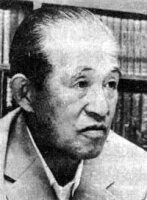| 籍贯: | 北海道旭川市 | ||||
阅读井上靖 Yasushi Inoue在小说之家的作品!!! | |||||
性别:男
出生日期:1907年 5月6日
出生地点:北海道旭川市
逝世时间:1991年1月29日
星座:金牛座
井上靖,日本作家。历任日本文艺家协会理事长、日本笔会会长,1976年获日本政府颁发的文化勋章,现任日中文化交流协会会长。
井上靖出生在北海道旭川的一个军医家庭,从中学起就酷爱文学。他在京都大学哲学系毕业前夕所写的剧本《明治之月》(1935)曾被搬上舞台,应杂志征文所写小说曾多次获奖。大学毕业后,他在大阪每日新闻社任记者、编辑15年,1951年辞去报社书籍部副部长职务,专心从事文学创作。
1949年,井上靖以短篇小说《猎枪》和中篇小说《斗牛》名噪文坛,后者获1949年下半届芥川文学奖。井上靖的才能是多方面的,他出版过5本诗集,写过剧本、电影脚本、美术评论等,但主要成就是小说。仅新潮社就出版了他的小说全集32卷。井上靖的小说,能够选取一些有社会意义的题材,对日本社会的的种种弊端进行辛辣的讽刺和抨击,有它独特的认识价值。《斗牛》、 《比良山的石楠花》(1950)和《一个冒名画家的生涯》(1951)是他前期悉心经营的力作。进入50年代,日本文学开始转向反映战后生活,井上靖也把自己的眼光和笔触,从描写过去转而反映当前的现实生活,写下了像《城堡》(1964)、《夜声》(1968)等具有鲜明现实感的佳作。井上靖的历史小说蜚声艺苑,尤其是《天平之甍》(1957)、 《楼兰》(1958)、《苍狼》(1959)、《敦煌》(1959)等以中国古代历史为题材的小说多为人们所称道。他的长篇近作《孔子》正在《新潮》杂志连载,受到文坛瞩目。
井上靖-生平简历
井上靖1907年生于北海道旭川町的一个军医家庭。读中学时,他作为学生必须背诵杜甫、白居易和陶渊明等人的代表诗作,对《论语》也有所了解。1930年井上靖进入九州帝国大学法文系,读了2年便重新考入京都帝大哲学系美学专业。
井上靖在中学时期由接触到喜爱中国历史文化,进入大学后,更加自觉广泛地涉猎中国史籍。大学期间,他阅读了中国的《史记》、《汉书》以及《后汉书》等历史著作。1936年3月井上靖从京都帝大毕业。毕业前,《周刊每日》曾悬赏征文,他的长篇小说《流转》应征于1936年7月发表,因此就职于每日新闻社。他到每日新闻社工作后的次年爆发了中日战争,井上靖于9月应征入伍,作为士兵来到中国的河北省,4个月后他因病回国,同年退伍。
战争结束后,井上靖开始在关西地方的杂志和报纸上发表诗作,他经过长达20年在文学上的徘徊和酝酿而成熟起来了的积淀,骤然以诗的形式迸发出来了。自1958年处女诗集《北国》问世以来,先后已有《地中海》(1962),《运河》(1967),《季节》(1972),《远征路》(1976),《干河道》(1984),《星兰干》(1990)等多部诗集出版。 20世纪40年代末,井上靖开始创作历史小说,1950年以小说《斗牛》获芥川奖。1951年,井上靖辞去《每日新闻》的工作,走上专业作家的道路。
井上靖-获奖作品
公历 日本年号 年龄 获奖作品 奖项名称
1936 昭和11 29岁 《变化》 千叶龟雄奖
1950 昭和25 43岁 《斗牛》 芥川龙之介奖
1958 昭和33 51岁 《天平之甍》 艺术选奖文部大臣奖
1959 昭和34 52岁 《冰壁》 昭和33年度艺术院奖
1960 昭和35 53岁 《敦煌》、《楼兰》 每日艺术奖
1961 昭和36 54岁 《淀君日记》 野间文艺奖
1962 昭和37 55岁 放送劇「火の山」(小磐梯) イタリヤRTV国際グランプリ
1964 昭和39 57岁 《风涛》 读卖文艺奖
1969 昭和44 62岁 《俄罗斯国醉梦谈》 新潮文学奖
1969 昭和44 62岁 「モラエス全集」編集葡萄牙 ・インファンテ・ヘンリッケ勲章
1981 昭和56 74岁 丝绸之路取材 NHK广播文化奖
1981 昭和56 74岁 《天平之甍》 对佛教的贡献佛教文化奖
1981 昭和56 74岁 本觉坊遗文 新潮文学奖
1984 昭和59 77岁 先達詩人として 日本现代詩人协会表彰
1985 昭和60 78岁 多年文学上的业绩及对文化交流的贡献 昭和59年度朝日奖
1989 平成2 82岁 《孔子》 野间文艺奖
井上靖-中国历史小说
井上靖是一位大量取材中国历史、特别是从中国史传文学为素材进行创作的当代著名作家。他在人物的选取、人物性格的刻画以及题材的组织等方面具有鲜明的特点。在这类历史小说中,寄寓了作者对人生对历史的独特思索。中国史传文学的叙事模式等艺术实践经验等方面,井上靖也有所承受与借鉴。
井上靖的文学创作与中国史传文学有着紧密的联系。他一生创作了大量评论、随笔和诗歌,而小说创作更是其事业的核心。在小说中,井上靖写得最多、最成功的是历史小说,尤其是取材于中国历史的小说最为出色。他不仅在中国史传文学中撷取题材,以表现他对中国历史与中国文化的向往,对人生对历史的独特思考和见解,而且在艺术实践经验等方面,也对中国史传文学有所继承与借鉴。
井上靖在创作历史小说时,治学态度是严谨的。他不仅查阅大量文献,详尽掌握史料,而且其历史小说总是由史籍记载过的历史事变为线索,以历史人物的行动为主导,加以想象和发挥,即使是虚构部分,也力求做到历史的真实和艺术的真实的统一。日本有关史学家便认为,井上靖的中国历史题材小说,所写历史事件是真实无误,经得起推敲的。
井上靖有大量获奖的文学作品。1936年他的长篇小说《流转》获千叶龟雄奖,1950年小说《斗牛》获芥川奖。之后,他热衷于以西域为背景,发表了一大批作品,其中《天平之甍》获1957年日本艺术选奖和日本文部大臣奖;《楼兰》获1958年每日艺术大奖;《敦煌》获1958年每日艺术大奖; 《补陀落渡海记》获1961年野间文学奖;《俄罗莎国醉梦潭》获1967年日本文学大奖。在这些作品中,他没有完全拘泥于细节的真实。他通过古朴幽深的笔调,以艺术家的视角审视历史事件、历史人物,着重对人物性格内在矛盾及其复杂性的描写,开掘历史深层的断面,赋予作品以新的认识价值。他的作品,抒发了对中国传统文化艺术的深厚感情,揭示了华夏母体文化的深刻内涵,把读者带到那远古的遐想之中。井上靖的西域题材小说营造的艺术真实和客观的历史现实,达到了和谐,令人信服。
井上靖-敦煌情结
井上靖从孩童时代就对西域发生了兴趣,对敦煌向往之极。日本文化与中国文化有着深刻的血缘关系。作为一名日本文学家,一旦接触到历史,自然要到中国传统文化中去寻根溯源。而在浩繁的中国史料中,“敦煌”无疑是最响亮、最醒目的词语之一。
自本世纪初发现藏经洞后,大量珍贵文物散失到世界各地,敦煌文化从此闻名于世。井上靖从五十年代起,就全力投入到了以丝绸之路和敦煌历史为背景的文学创作中,参阅大量有关敦煌文化、经济、地理、历史的资料,还几次去京都,当面向敦煌学专家藤枝晃教授请教,走火入魔地一气写出了《敦煌》和一批反映中国西部的历史小说。1960年,他的历史小说《敦煌》荣获日本“每日艺术”大奖。他苦苦思索着什么时候能飞到他的小说的那片境地之中,体会和验证自己的作品。
1977年,他终于如愿以偿,来到憧憬已久的古丝绸之路和重镇敦煌。白雪皑皑的天山山脉,景色秀美的赛里木湖,雄宏神秘的莫高石窟,古今闻名的酒泉、玉门关,使他陶醉。他感叹地说:“真没想到敦煌竟与我想象中的这样相像。”“23年前我就写成了《敦煌》,可直到今天才头一次见到它,却一点儿也觉不出陌生。我与中国太相通了。”对井上靖来说,这是一次梦境与现实交织在一起的美妙的旅行。
1978年,当常书鸿和井上靖两位老人会面时,都兴奋不已,相见恨晚。从此以后,井上靖访问了中国27次。1980年,73岁高龄的井上靖,担任大型系列电视片《丝绸之路》的艺术顾问,与日本广播协会、中国中央电视台的摄制人员一起,又一次来到丝路古道,在戈壁骄阳的炙烤下,在大漠风沙的吹拂中追寻历史的足迹,实现了自己向世界观众介绍丝绸之路历史变迁的愿望。他的《敦煌》被德间康快拍成电影,在世界20多个国家放映,掀起了一阵“敦煌热”。无数人从《敦煌》故事中,瞪大了眼睛,开始注目中国西部的这块地方。更有大批人拿着他的西域故事书,登上了去敦煌的漫长旅程。
井上靖-事件年表
1926年静冈县立沼津中学毕业,在武者小路实笃等人的影响下,转向文学。
1930年进入九州帝国大学学习,加入诗刊《焰》社。
1932年从九州帝大转入京都帝国大学哲学科美学专业。
1935年放弃毕业考试,加入《每日新闻》社任记者。
1937年应征加入陆军,驻中国华北。
1938年退伍,继续从事新闻工作。
1946年任《每日新闻》社学艺部部长。
1950年以小说《斗牛》获芥川赏。
1951年退出《每日新闻》社,成为专业作家。
1955年任芥川赏选考委员会委员。
1957年发表描述古代日中文化交流的友好历史的中篇小说《天平之甍》,被誉为井上文学的代表作品之一。同年10月访问中国。
1958年以《天平之甍》获日本艺术选奖,并获日本文部大臣赏。同年发表描写古代中国与西域关系的小说《楼兰》。
1959年又发表小说《敦煌》、《河口》。
1960年以《楼兰》、《敦煌》两部小说获每日艺术大赏。同年开始编辑《井上靖文库》 ,共26卷。
1961年发表据《元朝秘史》创作的小说《苍狼之争》。同年与龟井胜一郎等访问中国,回国后,又发表小说《补陀落渡海记》,获第14届野间文艺赏。1963年赴南朝鲜访问,同年参加“鉴真和尚圆寂1200年纪念日本文化代表团”与安藤更生等访华。
1964年起任日本艺术院会员。
1965年赴中亚细亚考察 “丝绸之路”。
1969—1972年任日本文艺家协会理事长。
1972年任川端康成纪念会理事长。
1974年赴中国访问,同年任日中文化交流协会常任理事、日本文化财保护委员会委员。
1975年任日本作家代表团团长访华。
1976年获文化勋章。
1977年和1978年几度访问中国。
1979年任中日文化交流协会常任顾问。
Inoue is famous for his serious historical fiction of ancient Japan and the Asian continent, including Wind and Waves, Tun-huang, and Confucius, but his work also included semi-autobiographical novels and short fiction of great humor, pathos, and wisdom like Shirobamba and Asunaro Monogatari, which depicted the setting of the author's own life--Japan of the early to mid twentieth century--in revealing perspective.
Inoue, who is one of Japan's most prolific writers today, started relatively late as a novelist. He was forty-two when he published in 1949 his first works, the two novelettes Ryoju and The Bullfight, which the following year won for him the top literary prize in Japan, the Akutagawa Prize. His longer Tiles of the Tempyo Era deals both with art and ancient China; Lou-Lan and The Flood are short historical novels of China. Whether he is writing full novels, novelettes, or short-stories, however, Inoue's penchant for detailed, exhaustive research and historical accuracy give his stories a flavor of authenticity. Even the characters in his stories can often be traced back to historical individuals. In the spring of 1964, Inoue went to the United States to start his research on what he personally believes will be his magnum opus, a multi-volume treatment of first, second, and third generation Japanese abroad, particularly in the United States.
—Leon Picon, from the introduction to The Counterfeiter, published in 1965
Prizes
* 1950 Akutagawa Prize ---Togyu,闘牛
* 1957 Ministry of Education Prize for Literature ---Tiles of the Tempyo Era
* 1959 Mainichi Press Prize ---Tunhuang
* 1963 Yomiuri Prize --- Fūtō
Works
* The Bullfight, 闘牛
* The Hunting Gun, 猟銃
* Tiles of the Tempyo Era
* Tunhuang
* Shirobamba
* The Samurai Banner of Furin Kazan, 風林火山
* Lou-Lan and Other Stories
* Wind and Waves
* Journey Beyond Samarkand
* Blue Wolf: A Novel of the Life of Chinggis Khan
* The Counterfeiter and Other Stories
* Chronicle of My Mother
* Confucius
